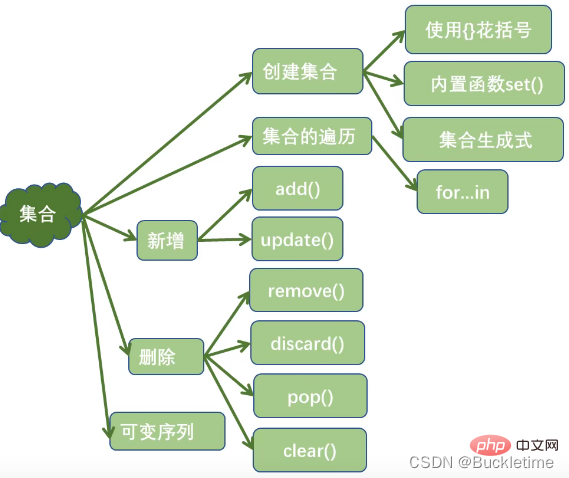
Cet article vous apporte des connaissances pertinentes sur python Il présente principalement des problèmes liés aux structures de données, notamment les nombres, les chaînes, les listes, les tuples, les dictionnaires, etc.

Apprentissage recommandé : Tutoriel vidéo Python
Type entier (int) - généralement appelé entier ou entier, est un entier positif ou négatif sans point décimal. Les entiers Python3 n'ont pas de limite de taille et peuvent être utilisés comme types Long. Booléen est un sous-type d’entier.
Type à virgule flottante (float) - Le type à virgule flottante se compose d'une partie entière et d'une partie décimale. Le type à virgule flottante peut également être exprimé en utilisant la notation scientifique (2,5e2 = 2,5 x 102 = 250)
Nombre pluriel ( ( (). complexe )) - Un nombre complexe se compose d'une partie réelle et d'une partie imaginaire, qui peuvent être représentées par a + bj, ou complexe(a,b). La partie réelle a et la partie imaginaire b du nombre complexe sont toutes deux flottantes. types de points.
int(x) Convertit x en un entier.
float(x) Convertit x en un nombre à virgule flottante.
complexe(x) Convertit x en un nombre complexe, la partie réelle étant x et la partie imaginaire étant 0.
complex(x, y) Convertit x et y en un nombre complexe, la partie réelle étant x et la partie imaginaire étant y. x et y sont des expressions numériques.
# + - * / %(取余) **(幂运算) # 整数除法中,除法 / 总是返回一个浮点数, # 如果只想得到整数的结果,丢弃可能的分数部分,可以使用运算符 // print(8 / 5) # 1.6 print(8 // 5) # 1 # 注意:// 得到的并不一定是整数类型的数,它与分母分子的数据类型有关系 print(8 // 5.0) # 1.0 # 使用 ** 操作来进行幂运算 print(5 ** 2) # 5的平方 25
index() : Trouvez la première occurrence de la sous-chaîne substr Si la sous-chaîne recherchée n'existe pas, lancez une exception ValueErrorrindex ()
rindex. () : Recherchez la dernière occurrence de la sous-chaîne substr. Si la sous-chaîne recherchée n'existe pas, une exception ValueError() est levée
find() : Recherchez la position de la sous-chaîne substr. une fois. Si la sous-chaîne recherchée n'existe pas, alors -1 est renvoyée.
rfind() : Recherchez la position où la sous-chaîne recherchée n'existe pas, alors -1 est renvoyée.
s = 'hello, hello'
print(s.index('lo')) # 3
print(s.find('lo')) # 3
print(s.find('k')) # -1
print(s.rindex('lo')) # 10
print(s.rfind('lo')) # 10
s = 'hello, Python' print(s.upper()) # HELLO, PYTHON print(s.lower()) # hello, python print(s.swapcase()) # HELLO, pYTHON print(s.capitalize()) # Hello, python print(s.title()) # Hello, Python
rsplit() : Séparer à partir du côté gauche de la chaîne Commencez à diviser par la droite
Spécifiez le nombre maximum de divisions lors de la division de la chaîne de caractères via le paramètre maxsplit , après le nombre maximum de divisions, les sous-chaînes restantes seront utilisées séparément comme partie
s = 'hello,Python'
'''居中对齐'''
print(s.center(20, '*')) # ****hello,Python****
'''左对齐 '''
print(s.ljust(20, '*')) # hello,Python********
print(s.ljust(5, '*')) # hello,Python
'''右对齐'''
print(s.rjust(20, '*')) # ********hello,Python
'''右对齐,使用0进行填充'''
print(s.zfill(20)) # 00000000hello,Python
print('-1005'.zfill(8)) # -0001005s = 'hello word Python'
print(s.split()) # ['hello', 'word', 'Python']
s1 = 'hello|word|Python'
print(s1.split(sep='|')) # ['hello', 'word', 'Python']
print(s1.split('|', 1)) # ['hello', 'word|Python'] # 左侧开始
print(s1.rsplit('|', 1)) # ['hello|word', 'Python'] # 右侧开始isdecimal( ) : Détermine si la chaîne spécifiée est entièrement composée de nombres décimauxisnumeric() : Détermine si la chaîne spécifiée est entièrement composée de nombres
s = 'hello,world' print(s[:5]) # hello 从索引0开始,到4结束 print(s[6:]) # world 从索引6开始,到最后一个元素 print(s[1:5:1]) # ello 从索引1开始,到4结束,步长为1 print(s[::2]) # hlowrd 从开始到结束,步长为2 print(s[::-1]) # dlrow,olleh 步长为负数,从最后一个元素(索引-1)开始,到第一个元素结束 print(s[-6::1]) # ,world 从索引-6开始,到最后一个结束
join( )
s = 'hello,Python,Python,Python'
print(s.replace('Python', 'Java')) # 默认全部替换 hello,Java,Java,Java
print(s.replace('Python', 'Java', 2)) # 设置替换个数 hello,Java,Java,Python%s chaîne%i ou %d entier
lst = ['hello', 'java', 'Python']
print(','.join(lst)) # hello,java,Python
print('|'.join(lst)) # hello|java|Pythonname = '张三'
age = 20
print('我叫%s, 今年%d岁' % (name, age))
print('我叫{0}, 今年{1}岁,小名也叫{0}'.format(name, age))
print(f'我叫{name}, 今年{age}岁')
# 我叫张三, 今年20岁
# 我叫张三, 今年20岁,小名也叫张三
# 我叫张三, 今年20岁# 设置数字的宽度和精度
'''%占位'''
print('%10d' % 99) # 10表示宽度
print('%.3f' % 3.1415926) # .3f表示小数点后3位
print('%10.3f' % 3.1415926) # 同时设置宽度和精度
'''{}占位 需要使用:开始'''
print('{:.3}'.format(3.1415926)) # .3表示3位有效数字
print('{:.3f}'.format(3.1415926)) # .3f表示小数点后3位
print('{:10.3f}'.format(3.1415926)) # .3f表示小数点后3位
# 99
#3.142
# 3.142
#3.14
#3.142
# 3.142可以存储重复数据
任意数据类型混存
根据需要动态分配和回收内存
语法格式:[i*i for i in range(i, 10)]
解释:i表示自定义变量,i*i表示列表元素的表达式,range(i, 10)表示可迭代对象
print([i * i for i in range(1, 10)])# [1, 4, 9, 16, 25, 36, 49, 64, 81]
in / not in
for item in list: print(item)
list.index(item)
list = [1, 4, 9, 16, 25, 36, 49, 64, 81]print(list[3]) # 16print(list[3:6]) # [16, 25, 36]
append():在列表的末尾添加一个元素
extend():在列表的末尾至少添加一个元素
insert0:在列表的指定位置添加一个元素
切片:在列表的指定位置添加至少一个元素
rerove():一次删除一个元素,
重复元素只删除第一个,
元素不存在抛出ValceError异常
pop():删除一个指定索引位置上的元素,
指定索引不存在抛出IndexError异常,
不指定索引,删除列表中最后一个元素
切片:一次至少删除一个元素
clear0:清空列表
del:删除列表
list.sort()
sorted(list)

Python的元组与列表类似,不同之处在于元组的元素不能修改。
元组使用小括号,列表使用方括号
t = ('Python', 'hello', 90)tuple(('Python', 'hello', 90))t = (10,)

items = ['fruits', 'Books', 'Others']
prices = [12, 36, 44]
d = {item.upper(): price for item, price in zip(items, prices)}
print(d) # {'FRUITS': 12, 'BOOKS': 36, 'OTHERS': 44}user = {"id": 1, "name": "zhangsan"}
user["age"] = 25
print(user) # {'id': 1, 'name': 'zhangsan', 'age': 25}user = {"id": 1, "name": "zhangsan", "age": 25}
user["age"] = 18
print(user) # {'id': 1, 'name': 'zhangsan', 'age': 18}user = {"id": 1, "name": "zhangsan"}del user["id"]print(user) # {'name': 'zhangsan'}del useruser = {"id": 1, "name": "zhangsan"}user.clear()print(user) # {}scores = {'张三': 100, '李四': 95, '王五': 88}for name in scores:
print(name, scores[name])scores = {'张三': 100, '李四': 95, '王五': 88}for name, score in scores.items():
print(name, score)
s = {'Python', 'hello', 90}print(set("Python"))print(set(range(1,6)))print(set([3, 4, 7]))print(set((3, 2, 0)))print(set({"a", "b", "c"}))# 定义空集合:set()print(set())print({i * i for i in range(1, 10)})# {64, 1, 4, 36, 9, 16, 49, 81, 25}两个集合是否相等:可以使用运算符 == 或 != 进行判断,只要元素相同就相等
一个集合是否是另一个集合的子集:issubset()
s1 = {10, 20, 30, 40, 50, 60}s2 = {10, 30, 40}s3 = {10, 70}print(s2.issubset(s1))
# Trueprint(s3.issubset(s1)) # Falseprint(s1.issuperset(s2)) # Trueprint(s1.issuperset(s3)) # False
s1 = {10, 20, 30, 40, 50, 60}s2 = {10, 30, 40}s3 = {20, 70}print(s1.isdisjoint(s2))
# False 有交集print(s3.isdisjoint(s2)) # True 无交集s1 = {10, 20, 30, 40}s2 = {20, 30, 40, 50, 60}print(s1.intersection(s2)) # {40, 20, 30}print(s1 & s2) # {40, 20, 30}print(s1.union(s2)) # {40, 10, 50, 20, 60, 30}print(s1 | s2) # {40, 10, 50, 20, 60, 30}print(s2.difference(s1)) # {50, 60}print(s2 - s1) # {50, 60}print(s2.symmetric_difference(s1)) # {10, 50, 60}print(s2 ^ s1) # {10, 50, 60}

推荐学习:python教程
Ce qui précède est le contenu détaillé de. pour plus d'informations, suivez d'autres articles connexes sur le site Web de PHP en chinois!